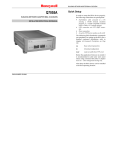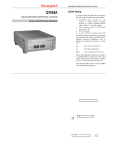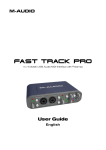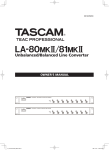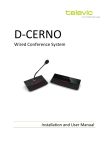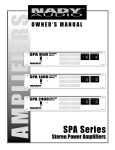Download Nady Systems 16 Recording Equipment User Manual
Transcript
DigiComp16booklet 1/23/03 10:26 AM Page 2 SERVICE FOR YOUR NADY AUDIO PRODUCT (U.S.) Should your NADY AUDIO product require service, please contact the Nady Service Department via telephone at (510) 652-2411, or e-mail at [email protected]. (International) For service, please contact the NADY AUDIO distributor in your country through the dealer from whom you purchased this product. OWNER’S MANUAL DO NOT ATTEMPT TO SERVICE THIS UNIT YOURSELF AS IT CAN BE DANGEROUS AND WILL ALSO VOID THE WARRANTY. DigiComp 16 NADY SYSTEMS, INC. • 6701 SHELLMOUND STREET, EMERYVILLE, CA 94608 Tel: 510.652.2411 • Fax: 510.652.5075 • www.nady.com 18-bit Digital Compressor DigiComp16booklet 1/23/03 10:26 AM DigiComp 16 — Page 4 18-bit Digital Compressor Specifications ELECTRICAL Frequency Response.................................................................................. 2dB from 20 Hz to 20 KHz Signal-to-Noise Ratio (process) ..............................................................>82dB linear, 20 Hz - 20 KHz Distortion.................................................................................................... <0.01% @ 1 KHz (-10dBV) Crosswalk.......................................................................................................... <90dB below full scale Thank you for your purchase of the DigiComp 16™ — you have purchased one of the finest compact sound processors on the market today. This unit was developed using the expertise of professional sound engineers and working musicians. You will find that your new NADY AUDIO sound processor has superior performance and greater flexibility than any other sound processor in its price range. Please read this manual carefully to get the most out of your new unit. FEATURES resolution ensures first-class/high-quality audio with negligible distortion, full bandwidth 20-20KHz response, and low noise/high dynamic range. • Exceptional assortment of 16 popular, one-of-a-kind preset digital compressor ROM programs, including AGC Pure, Acoustic, Master, Clean, Dance, Kick Drum, Mixdown, Jumping Up, and 8 Classic stereo settings with 16 user selectable parameter variations for each algorithm • Ultimate ease of operation with convenient front panel I/O signal gain controls, bypass switch, program and variations select controls; rear panel 1/4" I/O stereo and bypass jacks (for optional footswitch); versatile + 4 /-10dBu input signal level stereo/mono operation, high gain mono input for plugging instruments in direct, and 9 volt AC adapter supplied • Unique digital AGC and proprietary algorithms provide real dynamic compression for adding punch to weak signals, new dimensions to your sound and useful limiter functions. • Roadworthy, ultra portable, all-metal 1/3 rackspace rackmountable or tabletop housing • Advanced state-of-the art digital processing with 18-bit Sigma-Delta AD/DA conversion, high speed 12.5MIPs operation, and 52-bit accumulator Date of Purchase ________________________________________________________ Dealer’s Name __________________________________________________________ INPUT Number of Channels ............................................................................................................................2 Format ..........................................................................................................................1/4” unbalanced Sensitivity ..................................................................................................................................-10dBV Maximum Level ........................................................................................................................+10dBV Impedance ......................................................................1M Ω/channel stereo, 500K Ω channel mono A/D - D/A CONVERSIONS A/D converter ............................................................................................................1-bit Sigma-Delta D/A converter..............................................................................................................1-bit Sigma-Delta OUTPUT Number of Channels ............................................................................................................................2 Format ..........................................................................................................................1/4” unbalanced Maximum Level ..........................................................................................................................+9 dBu Output Impedance...................................................................................................................... <500Ω FRONT PANEL Controls ....................................................IN/OUT levels (ANALOG) PROGRAM selections (2 knobs) Indicators ..........................................................................................................Power, Signal clip LED REAR PANEL Input (LEFT/MONO, RIGHT) ..........................................................................1/4” 2-conductor (mono) Output (LEFT, RIGHT) ....................................................................................1/4” 2-conductor (mono) BYPASS......................................1/4” 2-conductor (auto-sense pedal type) (Momentary footswitches) Power ........................................................................................AC 9 Volt Power Transformer Adapter PROCESSING AND MEMORY Processor Speed ..................................................................12 MIPs (million instructions per second) Internal DSP resolution....................................................................................52-bit MPY accumulator Main Preset Program ........................................................................................................................16 Preset Total Combinations ..............................................................................................................256 SIZE Dimensions ................................................................................5.2” x 4.6” x 1.7” (131 x 116 x 44mm) Weight ..............................................................................................................................3 lbs (0.90 g) Address ________________________________________________________________ State ________________________________Zip ______________________________ The specifications above are correct at the time of printing of this manual. For improvement purposes, all specifications for this unit, including design and appearance, are subject to change without prior notice. Serial # ________________________________________________________________ 12 2 19 DigiComp16booklet 1/23/03 10:26 AM Page 6 Block Diagram Contents Warning ..................................................................4 Preset Function Descriptions Stereo AGC ..........................................................12 Dynamic Compression Process............................13 Installation Stereo 2 Bands Compressor ................................13 Inspection................................................................5 Stereo 2 Bands Compressor Preset ....................14 Desktop Use ..........................................................5 Mono 2 Bands + 5 Bands Eq Compressor ..........15 Rackmount..............................................................5 Mono 2 Bands + Bands Eq Compressor Presets ............................................16 Compression Effects Summary Table ..................16 Front Panel Controls Input Level Control ................................................6 Block Diagram ....................................................18 Output Level Control ..............................................6 Process Bypass Switch ..........................................6 Peak LED................................................................6 Specifications......................................................19 Power LED..............................................................6 Program Select Control ..........................................6 Variations Select Control ........................................6 Service ....................................................Back Cover Rear Panel Connections Power Jacks............................................................7 Bypass Jacks ..........................................................7 Input (Left/Mono &Right) Jacks ..............................7 Output (Left & Right) Jacks ....................................7 Installation and Connection Audio Connections and Power Up..........................8 Analog ....................................................................8 a. Input Jack Wiring ..........................................8 b. Level Setting ................................................8 c. Compression Process Bypass ......................9 Installation ..............................................................9 a. Standard Use ................................................9 b. 18 Application Examples ..................................9 3 DigiComp16booklet 1/23/03 10:26 AM Page 8 Wa r n i n g An equilateral triangle enclosing a lightening flash/arrowhead symbol is intended to alert the user to the presence of uninsulated “dangerous voltage” within the product’s enclosure which may be of sufficient magnitude to constitute a risk of electric shock. AGC ATTENTION: RISQUE DE CHOC ELECTRIQUE NE PAS OUVRIR An equilateral triangle enclosing an exclamation point is intended to alert the user to the presence of important operating and service instructions in the literature enclosed with this unit. IMPORTANT SAFETY INSTRUCTIONS When using this electronic device, basic precautions should always be taken, including the following: 1. Read all instructions before using the product. 2. Do not use this product near water (e.g., near a bathtub, washbowl, kitchen sink, in a wet basement, near a swimming pool, etc.). 3. This product should be used only with a cart or stand that will keep it level and stable and prevent wobbling. 4. This product, in combination with headphones or speakers, may be capable of producing sound levels that could cause permanent hearing loss. Do not operate for a long period of time at a high volume level or at a level that is uncomfortable. If you experience any hearing loss or ringing in the ears, you should consult an audiologist. AGC AGC AGC AGC AGC AGC AGC AGC AGC AGC AGC AGC AGC AGC AGC 1 2 3 4 5 6 7 8 9 10 11 12 13 14 15 EXP SPEED (dB/s) 3.5 3.5 3.5 4 3.2 3.3 3.2 4.1 4.1 4.5 4.5 5.6 6 6 6 CMP SPEED (dB/s) 23 19.5 19.5 24 24 22.5 24.3 23 23 24.3 22.5 24 19.5 19.5 23 EXP THR (dB) -61 -34 -42 -34 -44 -44 -37 -37 -37 -37 -44 -44 -42 -34 -61 CMP THR (dB) -26 -29 -26 -29 -29 -29 -29 -22 -27 -27 -27 -27 -27 -27 -27 THR HOLD (dB) -44 -32 -38 -31 -31 -42 -33 -31 -31 -30 -29 -42 -31 -30 -32 EXP RATIO (In:Out) 1:2 1:2 1:2 1:2 1:2 1:2 1:2 1:2 1:2 1:2 1:2 1:2 1:2 1:2 1:2 EQ CLASSIC PRESET 5. The product should be positioned so that proper ventilation is maintained. PEQ 1 PEQ 2 G=1dB; F=75Hz Q=1 G=1dB; F=75Hz Q=1 G=1dB; F=75Hz Q=5 G=2dB; F=50Hz Q=5 G=1dB; F=75Hz Q=1 G=1dB; F=75Hz Q=1 G=1dB; F=75Hz; Q=5 G=2dB; F=50Hz; Q=5 G=0dB PEQ 3 PEQ 4 PEQ 5 6. The product should be located away from heat sources such as radiators, heat vents, or other Classic 1 devices (including amplifiers) that produce heat. 7. The product should be connected to a power supply only of the type described in the operating instructions or as marked on the product. Replace the fuse only with one of the specified type, size, and correct rating. Classic 2 Classic 3 8. The power supply cord should: (1) be undamaged, (2) never share an outlet or extension cord with other devices so that the outlet’s or extension cord’s power rating is exceeded, and (3) never be left plugged into the outlet when not being used for a long period of time. Classic 4 9. Care should be taken so that objects do not fall into, and liquids are not spilled through, the enclosure’s openings. Classic 5 10. The product should be serviced by qualified service personnel if: A. The power supply cord or the plug has been damaged. Classic 6 Classic 7 B. Objects have fallen into, or liquid has been spilled onto the product. Classic 8 C. The product has been exposed to rain. D. The product does not appear to operate normally or exhibits a marked change in performance. E. The product has been dropped, or the enclosure damaged. G=-1dB; F=600Hz; Q=5 G=-1dB F=600Hz;Q=5 G=-10dB; F=100Hz; Q=5 G=-1dB; F=600Hz; Q=5 G=0dB G=-1dB F=600Hz; Q=5 G=-10dB; F=100Hz; Q=5 G=0,5dB; G=-0dB G=1dB; F=12KHz F=1KHz; Q=1 Q=1 G=-1dB; F=1KHz G=1dB; G=-1dB; Q=1 F=3.7KHz;Q=5 F=12KHz;Q=1 G=-1dB; F=1KHz G=-2dB; G=1dB; F=7KHz Q=1 F=3.7KHz;Q=5 Q=5 G=-6dB;F=1KHz; G=-4.5dB; G=2dB;F=10KHz Q=1 F=3.7KHz;Q=1 Q=5 G=-1dB;F=1KHz G=1dB; G=-1dB; Q=1 F=3.7KHz; Q=5 F=12KHz; Q=1 G=0.5dB; F=1KHz G=0dB G=1dB; F=12KHZ Q=1 Q=1 G=-1dB; F=1KHz G=-2dB; G=1dB; F=7KHz; Q=1 F=3.7KHz; Q=5 Q=5 G=-6dB; F=1KHz; G=-4.5dB; G=2dB; F=10KHz; Q=1 F=3.7KHz; Q=1 Q=5 11. Do not attempt to service the product beyond what is described in the user maintenance instructions. All other servicing should be referred to qualified service personnel. 4 17 DigiComp16booklet 1/23/03 10:26 AM Page 10 Installation This type of dynamic process is very useful for the dynamic control of instruments or “single” sounds. To ensure years of enjoyment from your NADY AUDIO DigiComp 16 sound processor, please read and understand this manual thoroughly before using the unit. Mono 2 Band + 5 Bands EQ Compressor Presets There are 8 presets available using the above algorithms: INSPECTION Your DigiComp 16 was carefully packed at the factory in packaging designed to protect the units in shipment. Before installing and using your unit, carefully examine the packaging and all contents for any signs of physical damage that may have occurred in transit. 1) Classic 1 3) Classic 3 5) Classic 5 7) Classic 7 2) Classic 2 4) Classic 4 6) Classic 6 8) Classic 8 These are all designed for use with single instruments. These presets are well tailored for use on classic guitars or acoustic instruments, where different equalizations of the sound (ranging from bright equalizations to warmer ones) can give the instruments more or less character and deepness. Compression Effects Summary Table LIMITER Band Split (Hz) AGC PURE ACOUSTIC MASTER CLEAN DANCE KICK DRUM MIX DOWN JUMP UP 800 2500 630 3150 160 250 5000 1250 Limiter Low Band (dB) 0 -2 -2 -3 -1.5 -1.5 -3 -1 Volume Low Band (dB) 0 2 4 0 6.5 8 2 2 Volume High Band (dB) 0 6.5 -4.5 5 2 2.5 2 4 COMPRESSOR AGC PURE ACOUSTIC MASTER CLEAN DANCE KICK DRUM MIX DOWN JUMP UP CLASSIC 1,2,3,4,5,6,7 Threshold (Hz) 0 -2 -2 2.5 -1.5 -0.5 -2 -1.5 -6 Release (dB/s) 33 34 30 50 86 32 57 6.5 16 Attack (dB) 111 29 111 72 137 25 72 85.6 (Note: Nady Systems is not responsible for shipping damage. If the unit is damaged in shipping, do not return to us, but notify your dealer and the shipping company immediately to make a claim. Such claims must be made by the consignee in a timely manner.) CONTENTS: • DigiComp 16 (verify that the same serial number is the same as shown on shipping carton) • AC Power supply adapter • Instruction manual • Warranty Card DESKTOP USE The DigiComp 16 may be placed anywhere safely as needed where it will not fall or be possibly damaged. Attach the rubber feet provided to the bottom of the unit if the unit is placed on a surface you wish to protect. (Note: The DigiComp 16 itself doesn’t generate any magnetic or hum fields, but it may pick up hum or noise from fields generated by power amplifiers. If it does, re-position the unit to eliminate the noise. Since the DigiComp 16 adapter may generate hum fields, locate it away from other audio equipment or wiring as much as possible.) RACK MOUNTING The DigiComp 16 has single rack height, and up to three DigiComp 16’s may be mounted side-by-side in a standard universal 19” equipment rack available from rack manufacturers or your music dealer. 5 DigiComp16booklet 1/23/03 10:26 AM Page 12 Front Panel Controls (3) (7) (6) (1) (2) (4) (5) Before using the DigiComp 16, it is best to familiarize yourself with the functions of all the controls and connections. After you have set up your unit, you should refer back to these descriptions to fully optimize operation in your paticular application. (1) Input Level Control The input level control sets the main input gain, before the signal reaches the input bus. It controls both Left (MONO) and Right input levels simultaneously. (2) Output Level Control The output level control sets the level going to the amplifer or mixer from this apparatus. (3) Process Bypass Switch This switch allows you to bypass the digital process to have the input signal available on the outputs. (4) Peak LED This displays the signal level being processed by the DigiComp 16. If the signal level is at overload, this LED will light red continuously and you might begin to hear the signal distort. Back off the INPUT CONTROL (1) until the LED lights only occasionally. brilliance. It is well suited for processing dynamic and brilliant recordings, increasing their "punch". 6) Kick Drum: In this preset, mid-low range is emphasized, while high and mid frequencies are slightly attenuated. This special preset is extremely well suited for drum recordings. It is ideal for underlining drums’ low range in multitrack recordings or mixed microphone environments. 7) Mixdown: Mixdown is less brilliant than Clean Preset and mid-low end is more pronounced. This is ideal for underlining bass and drums without losing definition in the rest of the range. This preset is also suited for harmonically complex instruments, e.g. double bass, which have a non-negligible high frequency range. 9) Jumping Up: The Jumping Up Preset is quite similar to Clean Preset in its general timbre, but this preset is particularly effective with male voices and is capable of maintaining the level in soft passages of a music program. For female voices, the Clean Program is generally preferred. Mono 2 Bands+ 5 Bands EQ Compressor The DigiComp 16’s Mono 2 Bands +5 Bands EQ dynamic process algorithm is based on a "multi-band" process concept, splitting the full band signal entering the dynamic process algorithm into 2 "sub-bands" — the low frequencies band and the mid/high frequencies band. This enables differentiation of the dynamic processes operating on the low frequencies (with higher energy content) and on the mid/high frequencies (with lower energy content). This technique avoids the common "pumping" effect which often occurs when applying a dynamic process to a sound signal. Once the input signal is split into 2 "sub-bands", the DigiComp 16 operates a first limiting process on the low frequencies band, and then, once the full band, is restored, it applies a powerful stereo dynamic process on the two "recombined" channels. The input signal to the dynamic compression "block" is the sum of the input signals filtered with a 5 bands parametric EQ. (5) Power LED This is lit whenever the DigiComp 16 power adapter is plugged in. (6) Program Select Control The Program select knob is used to choose the program you wish to activate. (7) Variations Select Control Each program on this apparatus has the AGC parameter which can be adjusted by means of this knob. 6 This feature allows you to modify the "color" of the input signal before applying the dynamic process. 15 DigiComp16booklet 1/23/03 10:33 AM Page 14 Rear Panel Connections This technique helps avoid the common "pumping" effect which often arises when applying a dynamic process to a sound signal. Once the input signal is split into 2 "sub-bands", the DigiComp 16 operates a first limiting process on the low frequencies band, and then, once the full band, is restored, it applies a powerful stereo dynamic process on the two "recombined" channels. (9) (10) (11) (12) (13) (8) (8) Power Jack This is a plug for connecting the Nady 9VAC power supply adapter (supplied). The DigiComp 16 comes with a power adapter suitable for the voltage of the country it is shipped to (either 110 or 220V, 50 or 60Hz). This type of dynamic process is very useful for the dynamic control of complex audio — a CD, an orchestra, etc. (Note: The correct power supply must be used AT ALL TIMES — any other power supply might create a fire risk and/or permanently damage your unit. This damage would NOT be covered under your warranty.) Stereo 2 Bands Compressor Presets 1) AGC pure: This preset is a simple automatic level control. Its speed varies with the different "variation" control positions. From a timbre point of view, it's a rather neutral process, and it doesn't alter the general balance of the original signal. It simply keeps the level in proximity of a fixed level, correcting the source variations. Note that variation 1 disables the AGC — it does so even in the compressor presets. This variation can be considered a sort of bypass. 2) Acoustic: The general impression this preset gives is of definition and power. The timbre is lively and brilliant, ideal for small ensemble music and keeping live soft passages. Frequency response is slightly rolled off in the low end. 3) Master: Master is very neutral and is usable as a high performance AGC. It can be put before power amps and recorders in order to optimize their dynamic range. Timbre is very similar to original signals, and so the unique appreciable differences are in the dynamic range corrections. Variations 2 through 16 activate even the AGC to enable variable compressor action. 4) Clean: This is a high definition preset, providing great brilliance and dynamic impression. Nevertheless it is never fatiguing and "pushes" the sound without unbalancing it. Highs and the punch range are emphasized and lows are not overly attenuated. It is great for underlining details in female vocals. 5) Dance: With this program, medium range and mid-low range are emphasized, while high frequencies are slightly attenuated. This helps control dance music’s intrinsic (9) Bypass Jack This is a 1/4” phone jack for connecting to an effects bypass footswitch. You can bypass the effects in two ways, thus allowing the direct signal to pass through the DigiComp 16 unchanged: 14 7 • By pressing the PROCESS BYPASS SWITCH (3), or by connecting a footswitch to this jack and pressing the footswitch. Each time this footswitch is pressed, the Bypass mode will turn on and off alternately. (10) & (11) Output (Left & Right) Jacks These 1/4” unbalanced phone jacks connect to devices such as the effects returns, channel inputs or inserts on a mixing console, or power amplifier inputs. For mono applications, use the LEFT (10) output. (12) & (13) Input (Left/Mono & Right) Jacks These 1/4” unbalanced phone jacks connect to sources such as the effects sends of mixing consoles. They may be used with nominal input levels from -8/9dBV. The Left/Mono input jack is normal to the Right jack. This means that when nothing is plugged into the RIght input jack, the signal present at the Left/Mono input is routed to the Right as well. DigiComp16booklet 1/23/03 10:33 AM Page 16 Installation and Connection Audio Connections and Power Up The connections between the DigiComp 16 and other audio devices have to be made using high-quality cables to insure optimum performance of this unit. It is best to use low capacitance shielded cables with a flexible internal conductor. Connect the cables to the unit properly by observing the following precautions: • Do not bundle audio cables with AC power cords. • Do not place audio cables and DigiComp 16 near sources of electromagnetic interference such as transformers, monitors, computers, etc. • Always unplug cables by firmly grasping the body of the plug and pulling directly outward. • Do not place cables where they can be stepped on. • Avoid twisting a cable or having it make sharp, right angle turns. Before powering up the DigiComp 16, check that all connections have been made correctly. • Turn down volume controls of the amplifier or mixer. Insert the Power plug into the POWER input on the rear panel of the DigiComp 16 and plug the power adapter into an AC outlet. Turn on the power of the amplifier/mixer and adjust the volume. Dynamic Compression Process As the name implies, compression reduces the dynamic range of a signal. It is used extensively in audio recording, production work, noise reduction, and live performance applications, and needs to be used with care. A compressor is basically a variable gain device wherein the amount of gain used depends on the level of the input. In this case, the gain will be reduced when the signal level is high, making louder passages softer and reducing the dynamic range. Analog a. Input Jack Wiring The DigiComp 16’s LEFT INPUT (12) jack is also the mono input for the unit. If you only connect a single mono cable to the LEFT INPUT (12) jack, it will also be routed automatically to the RIGHT INPUT (13). However, if you are using stereo input signals and also connecting a cable to the RIGHT INPUT (13) jack, the automatic routing will be avoided and the left input cable will feed only the LEFT INPUT (12), and the right input cable will feed only the RIGHT INPUT (13). b. Level Setting Proper setting of the input and output levels is crucial in order to achieve the maximum signal-to-noise ratio. It is usually best to set both input and output level controls at 3/4 or 75% of maximum. This will decrease the possibility of overload distortion and keep the amount of background noise to a minimum. If the Signal LED (4) on the DigiComp 16 lights up, signaling a process saturation, turn down the INPUT LEVEL (1) or decrease the volume of the source (instrument, mixer send, etc.). If the unit level is causing the mixer or amp to distort, turn the OUTPUT LEVEL (2) down. 8 A compressor’s input/output relationship can be illustrated by a simple graph: The horizontal axis corresponds to the input signal level, and the vertical axis is the output level (both measured in decibels). A line at 45 degrees corresponds to a gain of one — any input level is mapped to exactly the same output level. The compressor changes the slope of that line (makes it more horizontal) above some value called the threshold (which is most often adjustable). The height of the line defines the dynamic range of the output, and the slope of the line is the same as the compressor's gain. Stereo 2 Bands Compressor The DigiComp 16’s Stereo 2-bands dynamic process algorithm is based on a "multiband" process concept, splitting the full band of the input signals into 2 "sub-bands" — the low frequencies band and the mid/high frequencies band — in order to differentiate the dynamic processes operating on the low frequencies (with higher energy content) and the mid/high frequencies (with lower energy content). 13 DigiComp16booklet 1/23/03 12:50 PM Page 18 Preset Functions Stereo AGC The DigiComp 16’s dynamic process algorithm also includes a stereo Automatic Gain Control (AGC) "block" that, if used, is able to maintain almost stable the mean amplitude of the input signal, increasing it when the "average"of the input signal amplitudes seems to be low and decreasing it when the "average" of the input signal amplitude seems to be too high. This process is useful when the sound reaching the input of the DigiComp 16 is coming from different sources having different output levels and it is necessary to "NORMALIZE" the input level of the DigiComp 16 to obtain better performance from the c. Compression Process Bypass At any time you can bypass the process, thereby allowing the direct signal to pass through the DigiComp 16 unchanged. This can be done in two ways: • By pressing the BYPASS switch (3) • By connecting a footswitch to the BYPASS jack (9) and pressing the footswitch. On the back panel you will find a footswitch jack labelled BYPASS. This is a mono jack with connections for a standard footswitch. The footswitch must be plugged in before the DigiComp 16 has its power turned on — the DigiComp 16 will automatically recognize the right “polarity” of the pedal. Installation a. Standard Use The DigiComp 16 may be placed anywhere — on a table, on top of an amp, next to a mixing console. If it will be on furniture, use the rubber feet provided for the bottom of the unit. Make sure to place the unit’s power supply away from other audio equipment that may induce fields, and away from the signal wiring. It is possible that the DigiComp 16 may pick up noise fields generated by other equipment such as a large power amplifier. In this case, move the unit until the noise goes away. dynamic process operating as "second block" of the algorithm. 1) Expander Speed: This parameter represents the speed at which the signal is expanded beyond the Expander Threshold. This occurs only if the Max value is different from 0dB. 2) Compressor Speed: This parameter represents the speed at which the signal is compressed once it goes beyond the Compressor Threshold. This occurs only if the Min value is different from 0dB. 3) Expander Threshold: This is the threshold beyond which the signal is expanded. 4) Compressor Threshold: This is the threshold beyond which the signal is compressed. 5) Hold Threshold: When this threshold is crossed by the signal level, coming from the compression region, the compression coefficient is maintained steady. When the crossing is from the expansion region, the expansion coefficient is kept the same. 6) Max: This is the maximum expansion ratio between input and output in the expansion region. 7) Min: This is the maximum compression ratio between input and output in the compression region. The AGC = Const. areas are regions in which the multiplying coefficient value assumes the last calculated before crossing the different thresholds, so in the expansion area the COEF AGC value is increasing, while in the compression area the COEF AGC value is decreasing. 12 b. Application Examples Line Instrument — When connecting audio cables and/or turning power on and off, make sure that all devices in your system have their volume controls turned down. The DigiComp 16 has two 1/4” unbalanced inputs and two 1/4” unbalanced outputs. This input/output configuration may provide three different audio connection options: • Mono Connect an audio cable to the LEFT INPUT (12) of the DigiComp 16 from a mono source, and another audio cable from the LEFT OUTPUT (10) of the DigiComp 16 to an amplification system or mixer input. From Instrument or Effect Send To Mixing or Amplifier Console 9 DigiComp16booklet 1/23/03 12:01 PM Page 20 • Mono In, Stereo Out While still using the LEFT (12) mono input, connect two audio cables from the LEFT (10) and RIGHT (11) OUPUTS of the DigiComp 16 to a stereo amplification system or two mixer inputs. • Stereo Connect two audio cables to the LEFT (12) and RIGHT INPUTS (13) of the DigiComp 16 from a stereo source, and two other audio cables from the LEFT (10) and RIGHT (11) OUPUTS of the DigiComp 16 to a stereo amplification system or two mixer inputs. Insert jacks on the back of a mixer provide a way of "inserting" external processing equipment into the signal path. The insert occurs after the input amplifier, and before the channel fader; essentially it is the same as connecting the source (instrument or mic) into the DigiComp 16 before the mixer's channel input. Usually, insert connections require a special, stereo-splitting Y-cord. This Y-cord has a stereo 1/4” TRS jack that plugs into the mixer's channel insert socket, and two mono 1/4” TRS jacks (input and output) that will plug into the DigiComp 16. This kind of adapter cord will virtually insert the compression processing into one mixer's channel. Carefully adjust the DigiComp 16 input and output levels in order to satisfy the dynamic requirements of both the processed channels. If you don't hear anything, try to swap the Input and Output ends of the TRS cable plugged into the DigiComp 16. Do not use the effects send/return connections found on most mixers for effect modules, as this could result in heavy frequency response alterations. Mono In If you only want to use the DigiComp 16 for a mono input signal and to connect both of its outputs back to the mixer, you will need three audio cables. Connect a channel insert from the console to the LEFT mono input of the DigiComp 16 via TRS, and another audio cable from the LEFT or RIGHT output of the DigiComp 16 to an adjacent mixer input. Interfacing to a Mixing Console — The DigiComp 16 can accept mono or stereo sends at all system levels. The input circuitry of the DigiComp 16 can easily accept professional +8/9 dBu levels while having enough input and output gain to interface with the low signal levels of home recording systems. The DigiComp 16 may be connected to a mixing console connecting the unit directly to the channel insert socket of a single channel that is to be processed. Another way of interfacing the DigiComp 16 to a mixer or recording console would be in-line between the output of the mixing console and the input of a tape deck or power amplifier. This last setup would be used only if you wanted to process the entire mix. Stereo In - Stereo Out This connection is similar to the one described above. However, by utilizing two TRS cables and the console channel inserts, you can process two signals or a stereo signal (e.g., from a keyboard). This operational mode is the one used with the algorithms (1 to 8), designed to process audio stereo sources such as CD’s. Improper level setting when using a dynamic processor is the most common cause of noise and distortion problems, so always be careful to ensure optimum audio. Using Inserts — In the figure below, the situation is described in which the DigiComp 16 applies the desired dynamic process to single instrument signals; in this case, you must use a mixer that features individual channel inserts. 10 11










